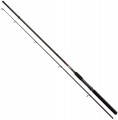Design
The general design of the rod. Most often it is folding —
plug -in or
telescopic — however, there are also
one-piece models. Here are the main features of each option:
— Plug. Such rods consist of several sections, which are completely disconnected in the stowed state, and before use they are connected to each other using bushings. On the one hand, this creates certain inconveniences: for example, for reliable transportation, it is necessary to place the fishing rod in a case or otherwise securely connect the components of the rod. Yes, and the process of unfolding / folding can be quite troublesome. At the same time, this design is considered optimal for rods designed for maximum accuracy and/or casting distance — for example, spinning, match and feeder rods (see "Rod Type"). Almost all such models are plug-in. Also note that you should not confuse the plug as a type of rod (see ibid) with this design option: plug-type models can formally be telescopic (this means that part of the rod looks like a “telescope”, see “Rod Type” for more details) )..
— Telescopic. She's "retractable". A design in which the sections have different thicknesses and are inserted one into the other in the folded position, and when unfolded they are alternately extended. Such a scheme provides maximum convenience during transportation — the rod is a “case itself” and does not requ
...ire additional cases or ties, unlike the plug-in design. At the same time, the "telescope" significantly reduces the accuracy of casting, and therefore it is used mainly where this parameter is not of decisive importance — in particular, in Bologna and flywheel models (see "Rod type").
— Whole. Solid rods are stronger and more reliable than composite rods, but they have one serious drawback: they cannot be folded for transportation and storage. Therefore, such a design is used relatively rarely — in particular, in individual spinning models of relatively short length, as well as in winter rods, which, in principle, do not need to be made long.Max. casting
The maximum weight of the entire rig (including bait, weights, hooks, etc.) that the rod can handle. This parameter is not recommended to be exceeded: the structure will be subjected to off-design loads and wear out a lot, to the point that the rod can simply break during a normal cast. In addition, the off-design weight of the casting significantly reduces the range and accuracy of the cast, which is critical, in particular, in spinning and match fishing (see "Rod type").
Min. casting
The minimum weight of equipment (lures, sinkers, hooks, floats, etc.) with which the rod will work effectively. Compliance with this parameter is important, first of all, for types of fishing that require high accuracy, for example, match or spinning (for more details, see "Rod Type") — a rig that is too light will not allow you to cast the rod far enough and accurately.
Sections
The number of sections provided in the design of the folding rod (see "Design"). Of two rods of the same length, a model with more sections will have a smaller length of each individual section and, accordingly, will be more compact and easier to transport. On the other hand, numerous sections adversely affects the overall strength of the structure. Therefore, when choosing, it is desirable to decide what is more important for you — ease of transportation or high strength.
Folded length
The length of the rod when folded. This parameter primarily affects the convenience of transportation: the shorter the folded rod, the easier it is to carry / transport.

